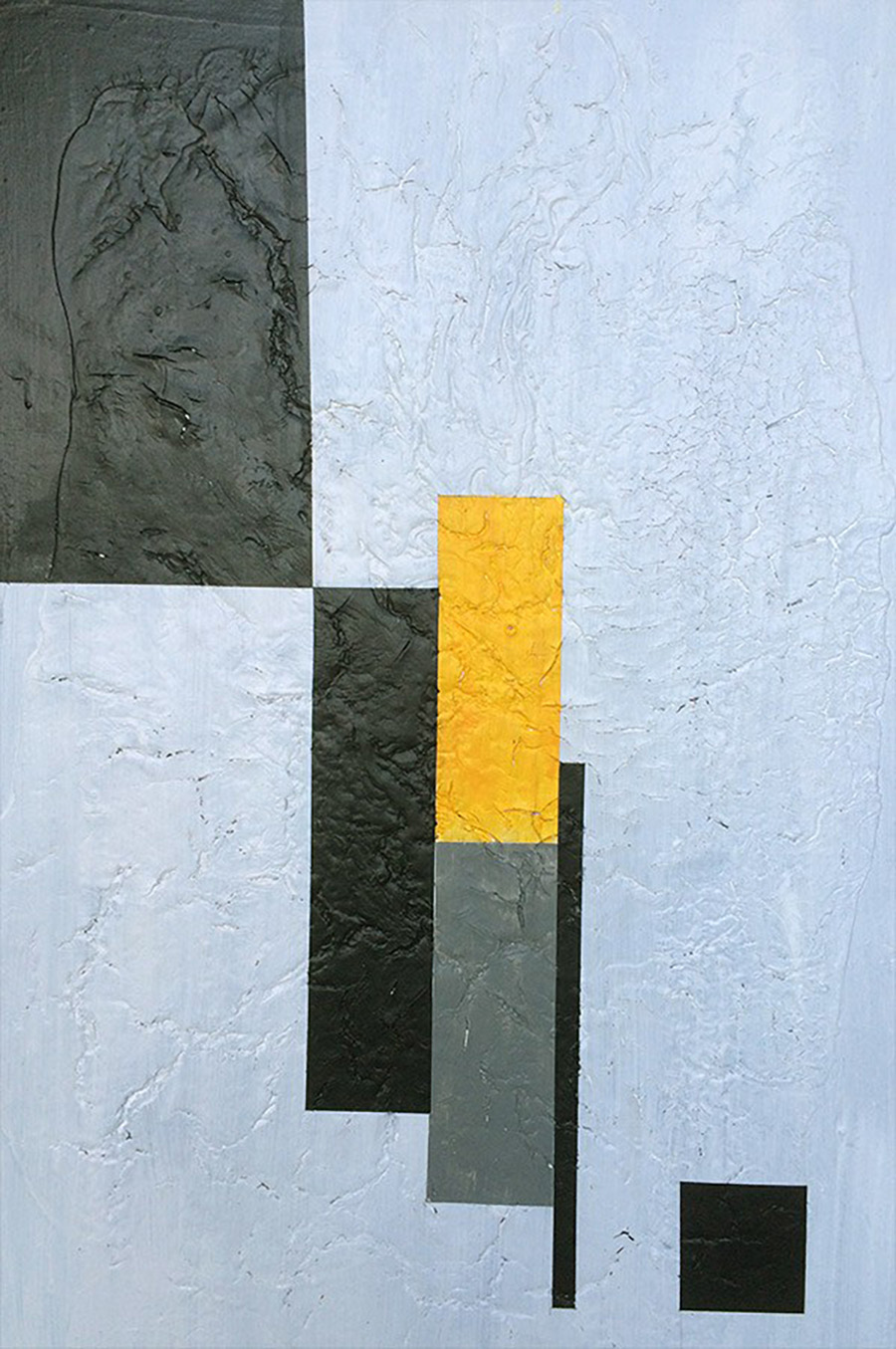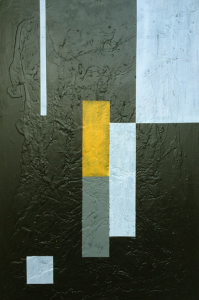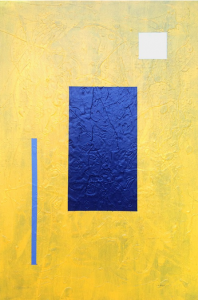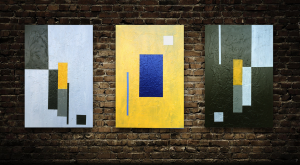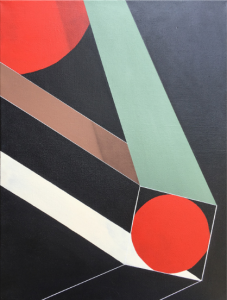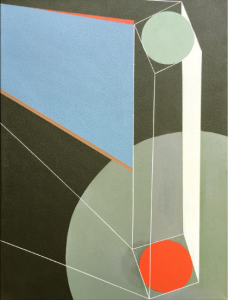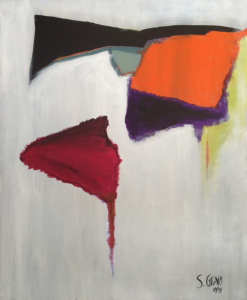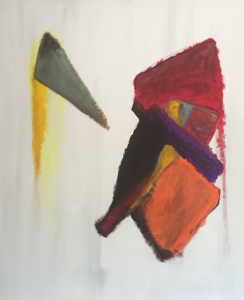Los Angeles based Visual Artist Soren Grau focuses on two opposite movements in art: Suprematism and Neo-Expressionism. Originally from Denmark, Grau has a unique sensibility that allows him to engage seamlessly with these two disparate artistic styles. More specifically, he is consistent in his ability to pull at the strings of our emotions, to tug sharply at those feelings knotted deeply within our guts, regardless of technique. Perhaps it is the rigorously applied layers of paint and passion that make up the soulful topography of his works; these tactile surfaces that are suggestive of the artist’s own emotions and creative process that draw us into each canvas-bound world he creates.
Employing bold colors and sharp symbolism, his paintings appeal to our emotions and ask that we feel our way into his works. To look at and appreciate his art is to engage with our own ability to empathize. For Grau the influence of empathy and emotion is critical. The chaos and struggle of existence is indeed present in his process — be it in the brushstrokes, color palate, or composition. However, this turmoil is balanced and refined by an undeniable sense of passion and love for the act of creating. Grau, who is reluctant to make sweeping statements about art or the role it has to play in our lives, nevertheless reminds us that both the creation and consumption of art is deeply individual.
You say that art is the most intense form of individualism, can you explain that?
Whatever an artist does, they put a piece of their soul into the artwork. In that way you can show who you really are. It can be gentle. It can be provocative. It can be minimalist. Whatever it is, whatever your style is, you can make yourself individual by creating something unique that is a part of you but that can also be a part of those who see it and experience it.
Tell me about these two styles of painting and how they communicate your own experience.
These pieces are painted from moods. On my dark days that’s when the Neo-Expressionism comes in. It is aggressive, like graffiti, and is ugly turned beautiful or perhaps the beautiful turned ugly. It is anger. And the other (Suprematism), which I prefer, is the gentle, minimalistic more constructivist painting – where everything is order and not chaos – nature versus human society. As an artist I sometimes feel as if there is this ugly monster inside of me and it wants to take over everything I do. But then there is the process of making art and getting that monster out, to show it, and then to make something beautiful.
What is your process like?
Neo Expressionist painting is a quicker process. It is done almost with just two brushes. I have done my research, made my study, and then I can turn off my mind and paint. I know what I have set out to do and I have the subject matter clear in my mind but the details that come out in the canvas are an obscured vision of the subject. Painting – it’s something you set out to do with love or with hatred. Say you are angry, then you smear the paint on. I mean you have to know what you are doing. But there is no room for over thinking. I mean, you are in it. You are paint!
How does the process affect you? What is it like to finish a work?
It’s a relief when I’m done. Having finished a painting is the best feeling. When I’m done and out of breath and looking at the work I feel like I can say ‘Nothing else matters! I love this.’ The process is the painting. And I don’t ever walk away from a painting. There is no rest. It is a fight. You are fighting with the painting. It can’t win. I mean, aside from allowing sections to dry, I don’t walk away. I don’t leave a painting for a night and then come back and ask myself what I’ll paint next. No, it’s planned. I’m very detail oriented. This is why I do studies – I don’t want to waste time or materials.
Do you credit your detail oriented painting process to your background in graphic design?
Somewhat, yes. I have technology and tools readily available that no one had thirty years ago. The gift I have with graphic design has influenced how I plan some of my constructivist paintings but it is not fun or fulfilling for me to use a screen or a computer for my own art. Because it is cold and it is two-dimensional. So, I have to make it come alive on the canvas. The scale and method of doing the minimalist work is accuracy. Subjects are measured out and contemplated. I don’t leave anything up to circumstance. Because once you start painting – you can’t make mistakes – the corrections become visible. And I hate that.
Do you ever improvise while working on a painting?
Improvisation can play a part in the Expressionism but there is still a plan. But these two different styles are almost as if I am two different painters doing the work. Regardless, the reality of the artwork can be and often is different from the vision in my head. But that’s why a study is helpful to me. I don’t rush and I really think about the work. You may or may not like what I do but whatever I do nothing is coincidental.
What are you enjoying most about the process?
It might sound a little corny but my process, from conception in my mind all the way to the finished product, is like a birth. There is an immense pleasure in producing something from my core and to see people respond – the reward is in this sensation.
Do you feel that technology – from production to promotion is helpful or a hinderance to your art?
These are two different worlds. When you are a graphic artist or technological designer you don’t get any actual respect from the art world where people paint, dance, act, or write poetry. I think they would argue that it is too easy. But having done this all my life, I meet people who say this, and they don’t know what they are talking about. I mean look at Pixar, if 3D animation was a piece of cake, we’d all be doing it. And really, many contemporary artists are using technology in their processes to make their work. But in the other direction, graphic artists do seem to have respect for those working in more traditional mediums. It’s an issue of established art snobbery.
How are your graphics background and your current fine art practice working together?
I’ve never been a conformist. Fuck conformity. I know a lot about digital art and graphics. But I also know a lot about the people in that world. So I know how to build something to draw people in. I’ve made a website for my art and sent emails and people have responded. They are buying the work and I have commissions. I mean, I could have approached galleries and more traditional structures to pursue this career, but why?
Who are your favorite artists?
I like Jackson Pollock a lot. But I think my all time favorite is Clyfford Still who was painting at the same time as Pollock and Rothko. He didn’t have much patience for the art establishment either.
What does success look like to you?
I have success. I had it when I made my first painting. I mean how do you want to measure this? I want to measure it in self-joy. I don’t really care for measurement in money or recognition. What I do like is when people I respect say they enjoy my work and they meant it. That refuels me. If someone buys my painting that is good. But that is not where the real meaning is for me. After all, every painting I make is made by me for me. Even if it isn’t ultimately for me. But that is what we artists do – that is the individualism we spoke of earlier.
Visit sorengrau.net to see more of Soren’s paintings and learn more about his work. All photographs courtesy of the artist.

